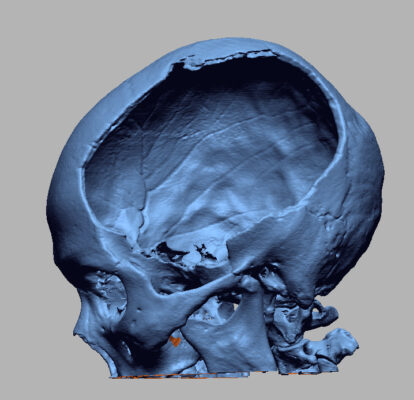Manufacturing successfully cranial bone graft products for patients requiring surgery cranial defects using PEEK biomaterial materials and 3D printing technology is a new progress with social and humanity meaning. This result is expected to help build the domestic production for medical grafting equipment from biomaterials, reducing dependence on imports.

A New Scientific Advancement
Preserving cranial bones and using autograft for patients with open the skull has been globally applied for a long time. However, in many cases, patients’ cranial fragments cannot be reattached due to various reasons such as multiple fractures or subsidence. In such situations, treatment necessitates the use of substitute materials like polyether, titanium, ceramics, PEEK (a high-temperature-resistant plastic). Among these, PEEK is currently the best biomedical material, meeting criteria such as biological compatibility, non-inflammatory response, elimination compatibility, chemical inertness, non-carcinogenicity, ease of sterilization, and manufacturability. In Vietnam, PEEK has been clinically tested in a Ministry-level research project as a medical product in the form of cranial grafts and torus mandibularis (products not manufactured using 3D printing technology).
Based on references from global and domestic research works, the author group, including Assoc. Prof. Dr. Ngo Duy Thin, MSc Vu Chi Hieu, and colleagues (Ngoc Bao Healthcare Company, 117 Thai Ha Alley, Dong Da, Hanoi), developed a design process for creating customized the cranial vault from peek material using 3d printing technology, relying on patient-specific film data.
The method of manufacturing cranial grafts from PEEK material exhibits high biological compatibility, suitable for each individual patient. The product has several advantages, such as no size limitations for all areas, suitable for various types of injuries, including craniofacial injuries; pre-manufactured, facilitating surgery, simply requiring the graft to be fitted into the cranial defect area. Besides cranial regeneration, this method can also be applied to create longer bones, such as arm or leg bones.
“In the current production process, the most challenging step is printing products from PEEK material. From CT (computed tomography) or MRI (magnetic resonance imaging) films, we create three-dimensional spatial designs with dimensions and shapes suitable for each patient, then proceed to 3D printing software design using PEEK material. Once we have the product, we make adjustments, package, and sterilize it. With such advanced technology and materials, we produce personalized cranial grafts,” said Assoc. Prof. Dr. Ngo Duy Thin, Chairman of the Board of Directors of Ngoc Bao Biomedical Joint Stock Company and project leader.
Notably, the cranial graft is designed with ears to attach anti-subsidence screws, reducing the need for fixed braces. This is a new invention originating from Vietnam, marking the first occurrence of such a structure globally.
Prospects for the Development Direction
In 2021, the Hanoi Department of Science and Technology approved the implementation of a city-level experimental production project titled “Perfecting the manufacturing process of cranial and facial graft products from PEEK biomaterial using 3D printing technology.” The project supplied customized cranial grafts made of PEEK material to Hai Duong General Hospital, contributing to the successful surgery of over 30 patients. Additionally, Bach Mai Hospital, Bai Chay Hospital (Quang Ninh province), and the Central Maxillofacial Hospital also performed blepharoplasty for 10 patients. The products are manufactured from PEEK material with 3D printing technology, perfectly suitable for each patient, with short surgery times and good stability of the grafts.
The work of creating customized cranial vaults from PEEK material using 3D printing technology by the author group led by Assoc. Prof. Dr. Ngo Duy Thin won the Second Prize in the 16th National Technical Innovation Contest (2020-2021) organized by the Vietnam Fund for Technical Creativity Support (VIFOTEC).
According to Dr. Le Xuan Thao, Permanent Vice Chairman of VIFOTEC, the project is highly praised for its creativity, novelty, socio-economic efficiency, and broad applicability in our country’s conditions. The product meets all the requirements of patients for cranial defect surgery with various sizes, positions, and shapes. The surgical technique is simple and can be widely applied to provincial hospitals across the country, achieving high aesthetic results with a reasonable cost compared to other products in Vietnam.
This project is an advanced technology with social and humanity meaning, opening up new development directions for orthopedic surgery in general and joint regeneration surgery in particular. Assoc. Prof. Dr. Ngo Duy Thin aims to further develop this technology for manufacturing medical grafting devices in the body, such as replacing bone segments for bone cancer patients in the upper and lower limbs. The ultimate goal is to build domestic production for medical grafting equipment using biomaterials, reducing dependence on imports.


 Tiếng Việt
Tiếng Việt


